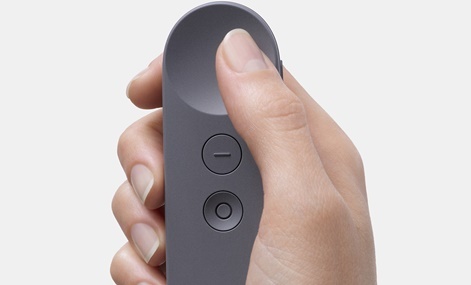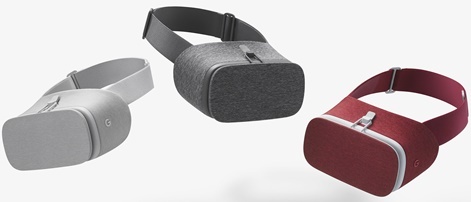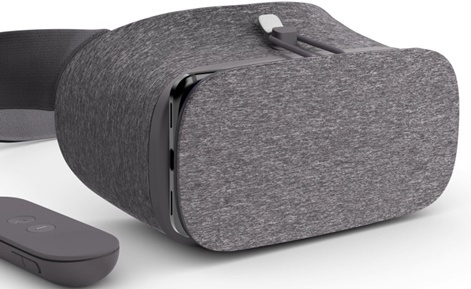It’s been easy to be sceptical about virtual reality.
For all the money spent in the last few years in the space, not least Facebook’s $2 billion acquisition of Oculus, it’s been a long road to consumer VR.
But now all the major players have arrived. The Samsung Gear VR is out, as is the Oculus Rift and the HTC Vive. The PlayStation VR will launch in just a week’s time on October 13th.
And now Google has shown its hand (again). Building on Google Cardboard, a cheap VR offering that has shipped over five million units, it has just revealed the Google Daydream VR headset.
Google Daydream View takes the fight directly to the Samsung Gear VR. It will cost just £69, less than the Gear VR’s initial £80 price (though you can now pick up a Gear VR for £52, minus a controller).
Google’s headset meanwhile ships with a motion controller at no extra cost. That’s more than can be said for the disappointing decision not to ship the Oculus Rift with the Oculus Touch – which are a pair excellent VR controllers. Though a more traditional controller can be used with Gear VR, it must be bought separately.

But what Google has done here is not simply tack on any old controller. As the company itself says, users can use the controller to "swing a bat, steer an airship, or even cast a spell with a magic wand" (The latter of which is a technique that will be used in Warner Brothers' Fantastic Beasts and Where to Find Them game - one of 50 titles coming to Daydream this year).
By using something more user friendly and reminiscent of the Wii remote, it could set the standard control scheme for mobile VR that others will follow.
It may not be as precie as the HTC Vive, but does it need to be?
Untethered
Currently, Daydream is only confirmed as compatible with the new Google Pixel smartphones running on Android Nougat 7. But it has previously announced hardware partners such as HTC, Samsung, LG, Xiaomi, Huawei, ZTE, Asus and Alcatel.
If more Android smartphones become readily compatible with Daydream, it gives Google a significant platform to build up a large VR userbase. Google understandably wants to sell its own hardware, but it's a surprise that manufacturing partners were not mentioned during or after the announcements.
Mobile offers a much bigger market than will ever be available to the Oculus Rift and HTC Vive in their current forms. Owning a powerful smartphone is nowhere near as big a hurdle for consumers to overcome as it is to purchase a PC or console, and then a headset on top.
The only question they need to ask for Daydream is if they have an iOS or Android phone.

Google Daydream VR costs £69, comes with motion controller reminiscent of the Wii remote and is wrapped in a more welcoming fabric design than the hard casing of its competitors, a nice touc h that makes the whole thing a more enticing and accessible package.
Though I’m sure Samsung and Oculus won’t go down without a fight (Samsung is in the odd position of supporting its own hardware and Daydream), Daydream View leaves competitors playing catch up.
You can tell someone the Rift is more powerful and will have better graphics – maybe even a better experience – but it's too expensive right now.
Google offers an entry point for VR. And once someone has bought that good quality cheaper headset, it’s unlikely they’ll fork out for a more expensive headset to boot.
The social factor
One issue Google didn’t answer was how it would be tackling the social aspects of VR. You could argue that VR is still a non-social product.
But in today’s world of online connectivity, what does social really mean when it comes to technology and games?

When we think of ‘social’ in this sense, really what we mean is connecting to others through social media, messaging apps, in-game avatars, voice chat and other means of communicating online.
You only need to look at the dearth of local multiplayer games on the PS4 and Xbox One to see that offline play has fast become a thing of the past, yet multiplayer gaming is bigger than ever.
It's not something you'll always bring out for when the family comes round, but it could easily fit in somewhere in your life at home.
VR for the masses
With Google Daydream View, VR is ready to start hitting the mainstream.
Samsung said back in May it had sold 300,000 headsets in Europe alone. At the same time Oculus mobile head Max Cohen said “one million people” had used the headset in April 2016.
Given the right support, it’s not difficult to see Google Daydream VR hitting big numbers and becoming the leading virtual reality headset on the market over the next year and selling millions of units.
Google’s tech is the closest yet at bringing VR to the masses, and sets a tough benchmark for others to beat.





















